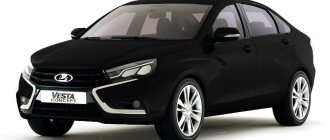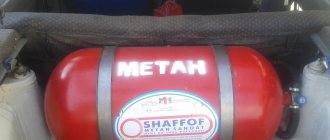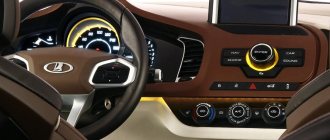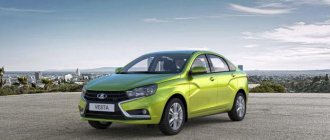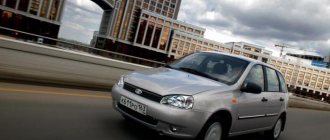With the start of production of serial Lada Vesta, AvtoVAZ proved that it can produce competitive cars. These gray cars have received a good modern design of both the exterior and interior, and in technical terms they are equipped quite acceptable for a car in the price category to which Vesta belongs. However, only a long test drive of the Lada Vesta will allow you to understand how good the new sedan from AvtoVAZ is. It is the user's view that makes it possible to see and determine the positive and negative qualities of this sedan.
Sedan capabilities
After a test drive of the car was carried out in the city and on the highway, it was decided to drive on a country road. And due to the almost 18 cm of ground clearance, we were able to easily drive in those places where the Rio and Solaris began to touch the ground with their bottoms. Vesta, practically without slowing down, drove along a very deep rut, while the SUV drivers in front were in bewilderment when the domestic Lada Vesta blinked its headlights behind them. Carrying out such a very extreme test drive for the sedan, we understood that there was a high probability that a tow would be needed, but the car continued to calmly cope with the assigned tasks.
Moving along the highway, the car holds well at high speeds, so before even a strong climb, you can not be afraid to accelerate and go into third gear. By the way, on the new Lada, we had to feel the traction control system only once, when we missed a necessary turn. Therefore, the pre-prepared shovel and the accompanying SUV for towing never had to be used.
When we returned to the city, all test drive participants came to a unanimous opinion about the car. It really is worth the price. By the way, we recommend that off-road enthusiasts take care in advance about installing good crankcase protection. The factory installed option does not have the required level of protection and therefore stones can damage the engine.
Pleasant to drive
Well, I saved the sweetest part for the finale. This is the only thing that personally determines for me whether to take it or not. The feeling of the car, or, to put it boringly, the reaction force on the steering wheel. And I was lucky that the test drive of the Lada Vesta took place in Italy with an abundance of not too smooth, but very winding paths. At one point my brakes even overheated, but the four of us in the cabin and with a full trunk made it down a very steep descent. And the point is not at all in the rear drum brakes, but rather in the excessively groovy nature of the car. It’s unlikely that I would dare to drive so fast in a Renault or a Korean budget car. Even the German Polo sedan doesn't start that much.
Vesta is truly a pleasure to drive.
Lada Vesta is not as precise as Granta Sport, but it is many times more comfortable. For now, only imported electric power steering is installed on it, so it’s difficult to find fault with them, but stringing one turn onto another is a great pleasure. The balance of the chassis turned out to be completely neutral, it is almost impossible to send Vesta into a skid without the help of a handbrake, and the standard ESP stabilization system is turned off only at low speeds.
The only thing I haven’t tested in Vesta is the Era-Glonass system; it is offered here in the basic version, and we will definitely check it in Russia.
Having gone for a test drive of the Lada Vesta in Italy, we “locked tongues” with the Lada Vesta project manager Oleg Grunenkov. He told a lot of interesting things from the inner workings of AvtoVAZ and shared that now they are racking their brains over the question of whether Vesta is needed with a hatchback body? I, as a fan of this particular body, of course, immediately said “yes”, but then I remembered the X-Ray, which will go into production on December 15, and the beautiful Vesta Cross station wagon, which will appear on the assembly line on September 25 next year, and became very thoughtful: Is there a place for a stylish city hatchback in such a model range? What do you think? I will wait for him, although I am even more waiting for an “honest” machine gun on Vesta, not for myself, but for my fair half.
And I would like to hope that, in relation to the Lada Vesta, the well-known phrase “we wanted the best” will be perceived with a plus sign.
Video test drive, technical specifications below
Cost and start of sales
If we consider the 2022 Lada Vesta Cross car (new body) in the basic configuration, then its characteristics and prices, as well as photos, can be seen on our resource. The cost of the basic version of the car is 614.9 thousand rubles. In this case, the user receives the following elements:
- power windows;
- adjustment of the steering column according to such a parameter as the departure angle;
- a computer with the necessary options;
- lock (central), which is controlled remotely.
More advanced car configurations will be offered to the user for 730 thousand rubles and more. If we consider the top-end configuration of this car, then its cost will be 807.9 thousand rubles. This vehicle configuration includes the most advanced options and systems that are installed by the manufacturer.
The car will be presented in dealer showrooms in Russia this year, so potential buyers can already choose the appropriate configuration. In addition, this car will be offered to motorists in a number of European countries.
Autoreview
It is beautiful, but not cheap, handles well, but accelerates poorly, practical, but voracious.
Suspension
:
- The suspension of the Lada Vesta SW and Lada Vesta SW Cross is different. On the cross version it is more “asphalt”.
- The suspension is denser, reactions are faster and more accurate, with it Vesta Cross rolls less and sways less.
- But it emphasizes waves and irregularities more strongly.
Control
:
- The elevated Cross controls more accurately and tastes better.
- The cross costs 830 thousand, but drives like a million. Reactions are fast and accurate, rolls are almost not felt.
Clearance
:
Ground clearance is 203 mm - Crete never dreamed of this, and Kaptur is only one millimeter higher, but from experience there is more confidence in the Lada's passport clearance.
Noise insulation
:
- Unexpectedly good sound insulation (in a station wagon it is almost quieter than in a sedan).
- The roar of the engine is insipid, the turn signals click poorly, the horn snarls in the voice of a cold teenager.
Body:
- The rigidity of the station wagon body compared to the sedan dropped by only 100 Nm/deg and amounts to 17900-18900 Nm/deg. To compensate for the lack of a rigid rear shelf, the design has several additional elements that strengthen the body.
- We hung one wheel, all doors open and close without problems.
Fuel consumption
the Cross version in mountainous areas floated from 12 to 14 liters per 100 km.
Link #1 and link #2 for a test drive.
Design inside and design outside
According to many car enthusiasts, every good car should have a breed. It should be recognizable at first sight even in the absence of a car plant badge. Looking at the photo of Vesta, any domestic driver will recognize it as the brainchild of AvtoVAZ - the exterior of the car has been significantly changed compared to previous models, but is still recognizable.
New body lines have appeared, giving this new generation domestic sedan an aggressive look, indicating good power and a thirst for speed. Positive changes have also affected Vesta’s interior - the design of the dashboard, equipped with analog devices, will satisfy even the most biased critic. At the same time, the dominant materials in the cabin remained the same as in earlier versions of Lada cars - embossed plastic and woven seat upholstery (which, however, does not in any way reduce the value of the car interior design solution chosen by the manufacturer).
As you would expect, the first test drive of the Lada Vesta showed that the car has quite good characteristics for its price category. Naturally, there are some shortcomings in the form of an inaccurately configured ESC control system and the inconvenience of the interior for people over 190 centimeters tall - however, on the whole, AvtoVAZ was able to pleasantly surprise domestic consumers with the truly high quality of the new model. Will Vesta, the test drive of which Russian car enthusiasts have been waiting for, become the long-awaited revival of the domestic automobile industry? It’s impossible to say for sure, but it’s still worth hoping.
X-face outside
From the outside, the car looks quite modern, like an adult. The body panels fit perfectly: the gaps are minimal and even. The general X-shaped style can be seen everywhere: in the side stampings, in the front part, and in the rear headlights. The turn signals are built into the mirrors. There are neat aerodynamic roof rails on the roof, and the antenna is made in the form of a fin.
The only thing I didn’t like was the huge gas tank filler cap, which, judging by the sound of opening, was made of tin.
Also read: Which is better to take: a new LADA Vesta or a used Hyundai Solaris
Equipment
After a brief review of existing proposals, it becomes clear that the manufacturer has placed the main emphasis on representatives of the middle class. The Lada Vesta configuration has several standard options, designed for different levels of financial wealth of buyers, however, any buyer will be able to adequately supplement the chosen car with options not included in the standard assembly.
The opportunity to create your own Lada Vesta is a very thoughtful step by the manufacturer, making this car one of the most affordable. Undoubtedly, this Lada Vesta configuration policy can satisfy the needs of any driver, thanks to which this model will be successful on the market.
A little about the salon
Let's move on to the salon. The doors open easily, and you don’t need to make any special efforts to close them. The interior is good in terms of usable space; passengers clearly will not feel cramped.
The seating position is comfortable, and the driver’s seat and steering column adjustments allow almost any car owner to customize the driver’s seat.
The general appearance of the front panel is well designed by the designers, so it looks very good and stylish.
Vesta's visibility is very decent. The road is sufficiently visible, and large side mirrors allow you to clearly control what is happening to the side and behind the car.
The heated seats work just fine. They warm up quickly and within a couple of minutes the seats are warm. The storage box is very spacious.
But there are also disadvantages, although they are minor. These include a slight difficulty in reading information from the dashboard. And here the stylistic design is to blame. The wells are distracting with their shape and chrome, and the driver needs to pay more attention to the indicators of the sensors. Although, as you get used to it, this problem may disappear.
You can display a lot of information on the on-board computer, but the backlight is not very good, so the numbers are not very readable, and you have to look closely at them.
Setting up the computer is also difficult. Its function keys are located, as on many cars, at the end of the right steering column switch. The problem lies in the fact that to configure some parameters you need to perform certain manipulations - hold down both keys, hold them for a certain time, etc.
The location of the USB and AUX outputs, as well as the cigarette lighter, is also inconvenient. They were placed under the climate system unit in the rear wall of the storage niche. Therefore, getting to them is not very easy.
In general, it is better to set up the on-board computer and connect to the cigarette lighter before you start driving. But these are all minor flaws that can be found in any car. The overall impression of the cabin is that the build quality is slightly lacking. But for AvtoVAZ it’s forgivable. The rest of the interior is very good and in line with current trends.
Interior
The interior space of the new Russian-made product can please true connoisseurs of domestic cars. The chairs are very comfortable, and they have a large number of different adjustments that are designed to ensure a comfortable stay for people. In addition, there are a number of useful elements:
- steering column reach adjustment;
- convenient buttons and levers for controlling vehicle functions;
- the visibility of the situation is quite normal, but it is slightly obscured by the pillar located on the driver’s side;
- mirrors are large and comfortable;
- there is a lot of free space in the cabin;
- quite roomy trunk, allowing you to transport a lot of different cargo;
- original interior lighting, which is bright enough and does not have a harmful effect on vision;
- The seats are heated quite quickly.
This is interesting: Test drive Kia Sorento Prime
The interior has its own highlight: bright orange inserts that make the interior space more attractive and original. If a potential buyer is a fan of muted colors, then he can choose the option with gray inserts.
For an additional fee, you can purchase a multimedia package, which includes the following elements:
- multimedia system equipped with a seven-inch touchscreen display;
- navigation system;
- six functional speakers providing high-quality music sound in the cabin;
- a high-resolution camera providing visibility into the rear of the vehicle;
- wheel (steering) with many different functions;
- Cruise control.
Behind the wheel
About the engine:
- Faster, of course, than the 122-horsepower 1.8 engine, although it doesn’t deserve the title “sport”.
- The impressions from the 145-horsepower version of the 1.8 engine are approximately the same as from its original version. It reveals itself better on the highway than in the city.
About the suspension
:
She's fantastic. VAZ engineers managed to bring taxiing accuracy to new heights without losing one bit in energy consumption.
About the exhaust system
:
- First impression: why is it so loud? In the city with starts from traffic lights, this seems cool, but on the highway it quickly becomes annoying.
- From the outside, the sound is quite decent in volume and even has noble notes.
The car infected me with its spirit and even, damn it, made me think about buying it.
Link to test drive.
AutoVesti (Pavel Bludenov)
pros
:
- The suspension works great, the car is truly designed for Russian roads. Absorbs bumps well (better than Renault Kaptur).
- Excellent handling, even on bad roads.
Minuses
:
- Acceleration to 100 km/h is not impressive.
- The new instrument panel is blind, nothing is visible on it.
- AMT is not designed to be used.
- Multimedia system (the sun glares a lot and slows down).
- Below and above the engine behaves sadly.
- In 5th gear up a small hill the car does not accelerate at all.
Overall, the Lada Vestra SW turned out quite well. SW Cross seemed worse than a regular station wagon.
Ride quality
Vesta is equipped with two types of engines and two gearboxes. And this affects driving performance.
The base unit on Vesta is considered to be a 1.6-liter unit with 106 hp. With. This engine “moved” to the sedan from other AvtoVAZ models. It has already proven itself well in terms of reliability and maintainability. At the same time, it has quite good dynamic performance, but this also depends on the box used.
A manual test drive with this engine shows very good dynamic performance. The car quickly picks up speed and accelerates confidently. In general, this pairing of engine and gearbox on Vesta shows itself in an excellent manner. The only drawback is the need to independently control the gearbox, although for many car enthusiasts who prefer to have more control over the car, “mechanics”, on the contrary, is an advantage. In addition, such a box is highly reliable and has a long service life.
A test drive of the robot, which can also be equipped with Vesta with a 1.6 liter engine, showed slightly worse results in terms of dynamics. All the agility of the power plant is “eaten up” by the RCP. When driving in fully automatic mode and actively accelerating, the box is somewhat “stupid”, and switching is accompanied by quite noticeable “kicks”.
In manual mode, the robotic gearbox behaves a little better when accelerating, and then only due to driver intervention. But still, this box will not allow you to fully control your work.
A test drive of a Lada Vesta with a 1.8-liter engine and the same manual gearbox showed slightly better dynamic performance. Still, a more powerful motor has an effect. In addition, the box itself was “flashed” for this engine, which somewhat changed its behavior. The result was a decrease in the sensitivity of “kicks” when switching, and the box itself works more adequately.
This engine is not yet equipped with a manual transmission; we will test drive the Vesta 1.8 with a manual transmission separately, after a model with such technical equipment appears.
It is worth mentioning that Vesta is equipped with a considerable number of active safety systems, including ESP. This system is very useful and its presence on Vesta is a huge plus. The system works great when cornering and helps you start driving on loose snow without drifting or pulling the car. In general, the test drive of Vesta showed that this sedan is a domestic car that can “compete” with many foreign cars in its price category.
A video of a detailed test drive will tell you more about all the features of Vesta and its driving performance:
“Pros” and “cons” in comparison with an automatic machine (robot)
| Advantages | Flaws |
| Acceleration dynamics have become better, the car picks up speed faster | Increased fuel consumption in the combined cycle |
| The car is 30 - 35 thousand cheaper when purchased with a manual transmission | Crunching, creaking when driving at low speeds |
| Long service life | |
| Cheapness of spare parts and components | |
| The car is more expensive on the secondary market compared to the robotic version |
Prospects
The car in question, according to experts, may be of interest to the target audience for a number of reasons. Firstly, it has a rather attractive appearance, created using modern design approaches. Secondly, this is the modernization of systems and mechanisms, which led to an improvement in the dynamic and speed properties of this car. Thirdly, this is a fairly comfortable interior with good sound insulation, which is due to the use of modern high-quality materials, as well as new technologies.
The increase in popularity of the new car may also be due to the fact that the manufacturing company will make some changes to its design, as well as add certain technological options. Although the level of build quality of this car is quite high, improving a number of parameters in this direction will also have a positive effect on increasing sales volumes.
Work in the salon
Retainer
It is the plastic clamp, to which the drive cable is connected on one side, while the transmission lever is attached on the other, that is one of the possible reasons.
To get rid of sounds, it is recommended to place elastic material under the cable. This will cause the cable entering the clamp to rest against the lining. As a rule, simple electrical tape is used.
To do this, the tape is first glued in half (with the adhesive side inward), after which the cable is pulled out a little and the tape is installed. The cable is put back and it will push the tape into the lock itself.
It is recommended to carry out similar modifications for both clamps.
Ties and lining
The cables themselves are attached using plastic brackets, and a slight play is visible, which can also become a source of background noise.
Wheels.Ru
About the engine
:
- For traffic light racing, the Lada Vesta Sport is not fast enough at start. It feels like an ordinary inexpensive car with mediocre sound insulation and sluggish atmospheric traction at the bottom.
- Vesta Sport also doesn’t look like a highway star. The engine is not distinguished by its noble timbre, and there is a lot of noise in the cabin, and there are only five gears in the manual gearbox.
About the transmission
:
- The Renault JR5 gearbox does not howl like the VAZ one. The gear lever strokes are quite short and precise.
- The clutch pedal seemed a little long for a sports car and a little heavy for a civilian one - it doesn’t have Logan’s weightlessness, you have to apply effort.
About suspension and handling
:
- The chassis setup is outstanding!
- The suspension differs significantly. Despite the reduction in suspension travel from 80 to 40 mm, it remained comfortable, and it was only possible to break through it once - in a particularly treacherous deep hole with sharp edges.
- Vesta is very stable in corners. You can understand the whole meaning of this car by swinging the steering wheel at a speed of more than 80 km/h. The answer will be an accurate and understandable reaction.
About the brakes
:
- When braking from 60 km/h to zero, without touching the steering wheel, the trajectory does not change.
- According to documents, the braking distance from 100 km/h to zero for Vesta Sport was reduced from 40 meters to 34 - all thanks to reinforced brake mechanisms and 300 mm discs at the front.
Link to test drive.
Body and design
Steve Mattin once again proved his skills. Now every detail of the concept has been brought, if not to perfection, then presented in the best possible way. It is expected that the body will be fully galvanized.
The presented car is painted in bright orange. The black roof adds style and charm.
In the future, the station wagon will be painted in the same colors as the Lada Vesta sedan. Today there are 12 of them.
The plastic body kits and “skirt” attract special attention. The wheel arches protrude to the sides and add sportiness, which is more than enough in the concept
The car has the same length as the serial Vesta, which is 4410 mm. The wheelbase remains the same. Finally, Lada has got decent wheels. The 18-inch wheels look amazing. But so far there is information that seventeen-inch alloy wheels will be installed on production cars. Anyway, this is more than 15. The Lada Vesta Cross has become significantly taller. The ground clearance is increased by 2 cm compared to the sedan, in which it is 178. Whatever you say, the audience is looking at a real SUV with high cross-country ability.
There are innovations in design. The C-pillar is separated from the roof by a black insert, which creates an unusual visual effect. The optics and front part have not undergone any changes, unless we mention the chrome apron, which looks stylish under the characteristic X. However, given the off-road tendencies of the car, it is quite possible that the cross-country model will have to prove its cross-country ability more than once by overcoming steep climbs and potholes. In this case, the protective apron will have to be changed frequently. The rear of the Vesta Cross is also decorated with a shining shield.
As for the body changes, the rear doors clearly won. The opening is longer and fits better into the overall picture of the side of the car. As the test drive presenters noted, the station wagon is somewhat similar to the Ford Focus 3 from the side, only it has a significant advantage in terms of space in the back row.
The pride of the presented concept is its trunk. With the same depth as the sedan, it is much larger. This is not surprising, because now the rear doorway has a larger area. An adult man can easily fit into the cargo compartment, even covered by a bulkhead.
If you remove the bulkhead, then there is more than enough space. It is worth recalling that the trunk of the Lada Vesta has a volume of 480 liters. As in the sedan, the cross version contains a full-size spare wheel and an organizer under the trunk floor.
Reviews
| № | Positive |
| 1. | Dmitry , 33 years old (drive2.ru): they can’t say anything bad about the mechanics, the gearbox works properly. The car is only a year old, I regularly undergo maintenance, I don’t drive, I drive carefully. |
| 2. | Vyacheslav Petrovich , 47 years old (prom.ua): in a year and a half I drove about 20,000 km, mileage is above average. Impressions of the new mechanics are only positive. There is something to compare with; before this there was the Lada Granta. Grantmakers understand what I'm talking about. |
| 3. | Alexander Alekseevich , 43 years old (drom.ru): after buying the car, I changed the transmission oil for the first time at the 7000 km mark. I didn’t wait for 75,000 km, as the manufacturer recommends. The waste was of a natural color, metal shavings were present, but their quantity was insignificant. I did the same. |
| 4. | Alexey Petrovich , 48 years old (rozetka.ua): I’ve heard numerous negative reviews about the mechanics, I can’t confirm. I believe that the technical condition and performance of the unit depends on the driver. I don’t have any problems with this, I take care of my equipment. |
| 5. | Semyon Vyacheslavovich , 40 years old (Auto.ru): This is the second year since I bought and actively use a Lada Vesta on the mechanics. The review is positive, there are no comments about the work. |
| 6. | Vasily Timofeevich , 43 years old (Auto.Mail.Ru): for a year and a half of using a car with mechanics, he once made an unscheduled visit to a service station for diagnostics. I was at fault for the hum in the manual transmission, but it was the suspension. I hope that the device reaches the 180,000 km specified by the manufacturer. |
| 7. | Dmitry Gennadievich , 41 years old (drive2.ru): I like the mechanics more than the robot, I drove the AMT for three months, I can compare. Both robot and automatic are not adapted for domestic roads. The units do not last long, so it is better to buy a manual transmission. |
| 8. | Sergey , 35 years old (drive2.ru): on the mechanics, as soon as I pressed the pedal, I pressed it. And overtaking, and maneuverability, without kickdowns, delays in switching. Choice: definitely mechanics. |
| Negative | |
| 9. | Dmitry Semenovich , 52 years old (prom.ua): no matter how hard we tried, a miracle did not work. We decided to save several tens of thousands, but for the wrong reasons. It would be better to make the plastic cheaper than to install a Russian gearbox instead of a French one. Knocking and noise in the manual transmission was detected at 40,000 km. With such a low mileage there are such significant defects. |
| 10. | Gennady , 46 years old (Bibika.ru): after 30,000 km, cases of clutch slipping, delays when changing to higher gears, and howling of the gearbox became more frequent. You need to go to a workshop and order diagnostics. Couldn’t it have been done better from the start? |
| 11. | Boris , 38 years old (drive2.ru): at 25,000 km a gearbox whine appeared on a Lada Vesta. The officials said that the pressure bearing needs to be changed, but this is not certain. The final diagnosis will be announced after a comprehensive diagnosis. |
| 12. | Sergey Gennadievich , 45 years old (Avtodispatcher.ru): a knock in the gearbox was detected already at 31,000 km. Initially the fault was with the suspension, but after diagnostics the technician assured me otherwise. |
What will a Lada Vesta test drive allow you to check?
Many people wonder why there is a Lada Vesta test drive at all, and what characteristics it will allow to check. Of course, the Lada Vesta test does not mean that you will be allowed to delve into the inside of the car and personally check how all the systems work. However, with the help of a service such as a Lada Vesta test drive, you will be able to understand whether you are satisfied with the behavior of the selected car in appropriate conditions. If you are planning to purchase a luxury package, the Lada Vesta test will allow you to evaluate how well this package corresponds to your ideas about comfort and safety.
Which Lada Vesta models can be tested:
- A test drive of the Lada Vesta in the SV cross model will allow you to enjoy the maximum level of comfort and safety in any configuration. Lada Vesta SV Cross is available in three main trim levels: “Lux”, “Lux Multimedia” and “Lux Prestige”. All the main bonuses of this model are already available in the “Lux” configuration, and from the names of subsequent configurations one can guess what options will be added. A test of the Lada Vesta in any configuration will allow you to appreciate the high level of comfort and safety, smooth ride, ease of operation and many other positive qualities of this model.
- A test drive of the Lada Vesta SV model will allow you to make sure that the equipment you choose fully corresponds to your ideas about the optimal price-quality ratio. This model has an order of magnitude more configurations, and the cost remains extremely affordable, which allows you to significantly expand the choice. A test of the Lada Vesta SV in standard configuration will make sure that even the minimum configuration meets European ideas about comfort and safety, and this model is in no way inferior to more expensive analogues.
- A test drive of the Lada Vesta in the cross model will make sure that the new crossover is capable of surprising even those who are already accustomed to innovations in modern Lada models. Bright design, modern features, increased safety, high cross-country ability - all this can be felt and evaluated during a test ride.
- Testing the Lada Vesta in the CNG model will make sure that a car running on two types of fuel is suitable for you. Most often, this model is purchased for corporate transportation, as well as for filling taxi fleets. However, this model is being purchased more and more often for private use. It's all about high efficiency and quick payback, and the ease of use and level of comfort in this model meets the high bar set by the Lada Vesta family.
- A test drive of the Lada Vesta sedan model will allow you to evaluate how much you will enjoy driving the most affordable model in the Lada Vesta family. A large number of different configurations leaves plenty of room for choice. Meanwhile, the level of safety and comfort is still high, and the price for such a set of characteristics is amazing. Low fuel consumption in the urban cycle is an additional plus to the advantages of this model. Order a Lada Vesta test and see for yourself!
Review of the new AvtoVAZ product from a famous video blogger
One of the popular video bloggers, Anton Vorotnikov, known as Avtoman, could not resist his own test drive of the Lada Vesta. The hero of the video review is a red sedan with a robotic gearbox. The first thing a car enthusiast notices is the appearance of the car. A completely new design migrated from the conceptual X-RAY and Vesta, presented back in 2014 at the Moscow exhibition. To everyone's surprise, the production samples retained their original appearance.
Advantages
The author of the video notes many innovations that previous domestic cars did not have:
- silent opening and closing of doors;
- comfortable seating position for the driver, good seat height and tilt adjustment;
- ergonomic location of radio and climate control controls in the cabin;
- stylish design of the center console;
- sufficient space between rows of seats;
- good handling;
- energy-intensive suspension.
Flaws
During the autotest, Anton notes some disadvantages of the AvtoVAZ model:
- significant gaps between body parts;
- insufficient information content of the instrument panel;
- interior trim with cheap plastic;
- poor-quality assembly of interior parts: play in door handles and panels, presence of burrs on plastic parts;
- there is no fixation of the central armrest;
- poor sound insulation;
- drum brakes at the rear;
- delayed gear shifting on the “robot”.
Exterior overview
Let's start the test drive of the Lada Vesta 2022 with an inspection of the exterior. Overall, the car is made harmoniously and looks good. Vesta's review will tell you more about the exterior.
Among the positive qualities of the sedan regarding appearance, we can note decent headlights. They provide very good illumination, and the corrector allows you to adjust the optics over a fairly wide range.
Even with 16- and 17-inch wheels, the distance between the tires and the arches is decent, so there will be no problems when driving through snowdrifts and mud.
But it was not without its drawbacks. The negative aspects that the test drive of the Lada Vesta showed lies in the lack of seals between the windshield and rear window and the body. Because of this, a small gap will form between them, which will constantly be filled with water, snow, and dirt. And this is not very good in terms of protecting the body from corrosion.
Another drawback is the weak door opening at the bottom. They do not cover the sides of the threshold. As a result, the edge of the threshold quickly becomes covered with dirt, and it is very easy to stain clothes when getting into the car.
Otherwise, there are no particular complaints about the body assembly. Everything fits and fastens quite well, with even gaps.
Related link:
Lada Vesta SV and Lada Vesta SV Cross. What is the fundamental difference and which is better to choose?
Take it for a test drive
For example, it is difficult for me to determine the nationality of this car. So the new head of AvtoVAZ style, Steve Mattin, complains that he was looking for a domestic highlight, but never found it, and therefore chose the original X-shaped design for better recognition in the future.
Lada-Vesta: Steve Mattin assures that all subsequent Lada models will be designed in this style, and it will become a signature one.
So now we will need to thoroughly wash the corners of the famous letter. We were invited to sunny Italy for the first test drive of the Lada Vesta, where Vesta could not be afraid of dirt.
Lada-Vesta: Even in mountainous areas, off asphalt, the body remained clean.
Cuvette test Lada Vesta with and without ESP
The winter road promises many hidden dangers. Often the right side of the roadside looks like a snow-covered, flat surface. However, a very large number of motorists who, for one reason or another, have to drive onto it, annoyedly (and, alas, belatedly) end up in a real ditch, covered with a seemingly horizontal layer of snow.
Our new test of the Lada Vesta is designed to find out what advantages the ESP system provides, specifically designed to control the distribution of vehicle forces in difficult situations. For greater clarity, we decided to drive into a ditch and try to get out of it, first without the exchange rate stabilization system, and then using it.
Let's say right away that the car had to work hard. Almost in a dangling state, its two wheels balanced on the edges of the ditch - in this case, as a rule, it is almost impossible to do without outside help. But we dare to assure you that the factory electronics did not let us down. The on-board “brains” accurately dosed the injection of gasoline, allowing not only to let the car stand up straight, but also to climb onto the opposite side of the ditch, returning to the roadway.
Let us remind you that we performed all the above maneuvers with the ESP system engaged.
Next we disabled ESP. In this case, no attempts or tricks to move the car from an awkward position were successful. The wheels of the front axle only bit into the snow and ice harder and harder. In such a situation, leaving the ditch is possible only with great luck or with outside help.
RESULTS:
The test results revealed a clear benefit provided by the ESP system on the Lada Vesta. This applies to both smooth road surfaces and roads with poor traffic. In general, the presence of an electronic stability control system will be an excellent help for both beginners and experienced drivers - after all, when they want to help you, is it worth refusing?


